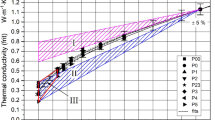Abstract
An experimental apparatus designed to measure automatically the internal friction and the elastic modulus of solid beams based on the resonance principle is described. The internal friction and the elastic modulus of porous Vycor glass beams containing different amounts of water has been measured as a function of temperature from 25 to −160° C. Two transitions are evident in the response: the capillary transition (−40 to 0° C) caused by freezing of capillary condensed water, and the adsorbate transition (centred around −85° C) associated with a gradual solidification of water adsorbed near the pore surfaces. More than half of all the water in a saturated beam freezes during the capillary transition, but this ice contributes only modestly to the elastic modulus of the beam which implies that there is little contact between the ice and the glass matrix. Further cooling into the adsorbate transition temperature range is believed to cause a gradual solidification of the adsorbed water, until at very low temperatures the adsorbed layer is “glassy” and effectively cements the glass matrix and the ice together resulting in a large increase in the elastic modulus of the beam.
Similar content being viewed by others
References
A. S. Nowick andB. S. Berry, “Anelastic Relaxation in Crystalline Solids” (Academic Press, New York and London, 1972).
I. M. Ward, “Mechanical Properties of Solid Polymers” (Wiley-Interscience, New York, 1971).
F. Radjy, Tech. Report No. 90, Dept. of Civil Engineering, Stanford University (1968).
F. Radjy andC. W. Richards,Materials and Structures 2 (1969) 17.
R. A. Helmuth, Tech. Report No. 154, Dept. of Civil Engineering, Stanford University (1972).
F. Radjy andE. J. Sellevold,Nature Phys. Sci. 241 (1973) 133.
Idem, Proceedings of the International Symposium RILEM/IUPAC, Final Report, Vol. IV, Prague (1974) p. C-189.
F. Radjy, to be published.
G. G. Litvan,J. Colloid Interface Sci. 38 (1972) 75.
Idem, Canad. J. Chem. 44 (1966) 2617.
A. A. Antonieu,J. Phys. Chem. 68 (1964) 2754.
R. F. Feldman,Canad. J. Chem. 48 (1970) 287.
R. Dufay, I. Prigogine, A. Bellemans andD. H. Everett, “Surface Tension and Adsorption” (Wiley, New York, 1966).
D. H. Everett andJ. M. Haynes,Bulletin RILEM, no. 27, (1965) 31.
Y. Morioka, J. Kobayashi andI. Higuchi,J. Colloid Interface Sci. 42 (1973) 156.
R. T. Pearson andW. Derbyshire,ibid 46 (1974) 232.
G. G. Litvan,J. Colloid Interface Sci. 45 (1973) 154.
J. J. Beaudoin andC. MacInnes,Cement and Concrete Res. 4 (1974) 139.
W. B. Kipkie, R. McIntosh andB. Kelly,J. Colloid Interface Sci. 38 (1972) 3.
Author information
Authors and Affiliations
Rights and permissions
About this article
Cite this article
Sellevold, E.J., Radjy, F. Low temperature dynamic mechanical response of porous Vycor glass as a function of moisture content. J Mater Sci 11, 1927–1938 (1976). https://doi.org/10.1007/BF00708271
Received:
Accepted:
Issue Date:
DOI: https://doi.org/10.1007/BF00708271




